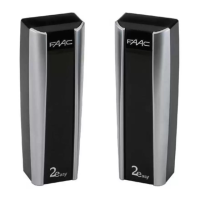3
RX - TX
TXRX
Fig. 4
4. ELECTRICAL CONNECTIONS
•Make the electrical connections on the terminal-
boards of the receiver and transmitter, using the
grommets, as shown in Fig. 4.
•The BUS consists of a pair of non-polarised
conductors.
•To make the connections to the control unit, consult
the specific instructions of the control unit being used.
5. START-UP
•The setting of the DS1 dip-switch determines the
address of each photocell. Every pair of photocells
(RX and TX) must have the same address.
•Every address must be unique for each pair of
photocells. The address determines the type of safety
device and its intervention (opening, closing, open/
closing).
To assign the addresses, refer to the instructions
for the control unit.
•Power up the control unit and make sure that the
DL2 LED lights up on both the receiver and transmitter
(Tab.2).
•Check the alignment of the photocells, controlling
the DL1 LED on the receiver (Tab.1).
2LD
NODETHGIL
THGILYDAETS
yltcerrocerewsnoitcennoc
edam
GNIHSALF
noitcennocSUBnotluaf
FFO
detcennocsid/gnitar
epoton
1LD
DETHGIL
tcerroctnemngila
FFO
tcerrocnitnemngila
DL1 = ALIGNMENT
DL2 = BUS/POWER SUPPLY STATUS
DS1 = SETTING DIP-SWITCHES
CONTROL UNIT
Tab. 1
Tab. 2
ATTENTION: for BUS 2 Easy connection use
cables with maximum diameter 0,5 mmq.,
maximum distance 100 m.

